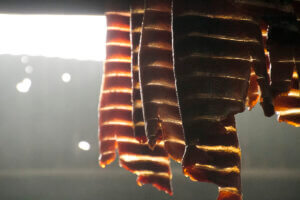By Gale K. Vick, Fairbanks Fish & Game Advisory Committee Member
 At the January 2024 meeting of the Yukon River Panel in Whitehorse, Canada, the Alaska Department of Fish and Game (ADF&G) and the Department of Fisheries and Oceans Canada (DFO) unveiled a draft “agreement” that, among other issues, is calling for a seven year stand down of any Chinook fishing on the Yukon River, except for discretionary cultural use and the transmission of cultural knowledge and minimal take for scientific purposes.
At the January 2024 meeting of the Yukon River Panel in Whitehorse, Canada, the Alaska Department of Fish and Game (ADF&G) and the Department of Fisheries and Oceans Canada (DFO) unveiled a draft “agreement” that, among other issues, is calling for a seven year stand down of any Chinook fishing on the Yukon River, except for discretionary cultural use and the transmission of cultural knowledge and minimal take for scientific purposes.
This is part of a “Rebuilding Target” plan between the two countries addressing the significant decline in the mainstem, or primary channel, of Canadian-bound Chinook over the past two decades. This initiative also serves as a means to assist in the restoration of severely depleted stocks on the U.S. side, particularly in the Chena and Salcha Rivers. The dwindling numbers in these rivers has raised concerns about the complete loss of discrete stocks.
Upon the announcement of this draft agreement, numerous concerns were expressed. Stakeholders along both sides of the border were not consulted, raising worries about the potential impact on the subsistence harvest of summer and fall chum. There is also concern that the entire responsibility for rebuilding Chinook stock on the Yukon River not be solely placed on Yukon River fishers. Numerous contributing factors, such as bycatch, intercept, and hatchery impacts, still need to be addressed.
However, at least one long-time Panel member, Andy Bassich of Eagle, calls the Agreement “the most important and meaningful action ever taken to begin the process of trying to save a stock from extinction.”
In 2003, the count of Chinook passing through Pilot Station, AK reached 318,088. Fast forward to 2023, and the number plummeted to 58,529, marking the second-lowest on record. (The lowest count occurred in 2022, with only 48,439 Chinook.) The present Interim Management Escapement Goal (IMEG) range for the Border is set between 42,500 and 55,000 Chinook. However, the escapement at the Eagle Sonar in 2023 recorded only 14,752 Chinook, highlighting a significant shortfall. Border crossing goals have remained unmet for several consecutive years. Notably, Canadian-bound Chinook constitute an estimated 50% of the total Yukon River Chinook, and none of the U.S. streams have achieved their Chinook escapement goals in recent years.
Virgil Umphenour, a Panel advisor and one of the original architects of the Yukon River Treaty, highlighted that relying solely on the Border crossing of Chinook doesn’t provide the complete picture. He emphasized that salmon still have up to 800 miles to travel to reach their natal streams, and this journey could represent only half of the Border crossing number.
At the Panel meeting, extensive discussions revolved around the mysterious decline of Chinook between Pilot Station and Eagle Station. Studies conducted at three locations along the Yukon in 2023 highlighted an increase in ichthyophonous, a disease known for causing grayish-white lesions on salmon’s internal organs and skin. These findings suggest that the disease could be a contributing factor to the decline in salmon numbers. However, others felt that the decreasing size of King salmon is creating smaller, weaker fish with insufficient energy to cover the up to 2000-mile journey. Virgil emphasized that later entries into the river were often referred to as ‘slow swimmers,’ possibly due to a lack of essential nutrients.
Chief Rhonda Pitka of Beaver discussed the incredible amount of flooding in the Yukon Flats and upper Yukon in 2023. She pointed out that due to reduced or halted fishing activities, there’s a loss of local observation along the river. She emphasized, “We are losing the local observations along the river. We used to hear ‘ground-truthing’ all the time.”
Erik Weingarth, the U.S. Panel member from St. Mary’s, noted that “stopping fishing alone is not going to change those factors.”
Dennis Zimmerman, a Canadian Panel member, pointed out that many of the presentations at the meeting were initially geared towards managing harvest, but it’s evident that harvest is no longer the primary concern. This shift in focus moves the conversation towards rebuilding and shifts the narrative. He emphasized that the ultimate objective is to “see fish on the spawning grounds.”
Elizabeth MacDonald, a Yukon Salmon Sub-Committee (YSSC) First Nations member emphasized that “we need to be worrying about extinction right now.”
Numerous delegates and public testifiers spoke passionately and eloquently during the proceedings. Canadian Elder, Don Toews from Marsh Lake, noted in December of 2022 that the Yukon River Chinook were “functionally extinct.” In January 2024, he reiterated this sentiment, emphasizing the need for a comprehensive plan and collaborative approach. Toews stresses the importance of collective effort to change across generations, preparing for the possibility of no harvesting in the foreseeable future. He stated, “If we really want Chinook in the system contributing ecologically and culturally, we know what we need to do. If we are wrong, and they recover in the next five years, that will be a miracle but not likely.”
Anticipating numerous discussions about the Agreement and rebuilding plans, there may be the prospect of a river-wide virtual discussion in March. Future articles will delve deeper into this critical issue.
Take Action Now!
- Watch the Panel Meeting. The entire public portion of the January 2024 Panel meeting can be seen on YouTube: https://www.youtube.com/watch?v=rL1vxwxkNy4
- Share Your Testimony! The Pre-Season Yukon River Panel meeting will be held in Anchorage, April 6th-11th, 2024. The meeting location is to be decided. Visit the Yukon River Panel page to learn more about the meeting: https://www.yukonriverpanel.com/meetings/?fbclid=IwAR0ApfTWK47i93FTSrLJxCFY5kzKW-8f_ExpmqUtLJdftCOQDbbapl5aDB8
